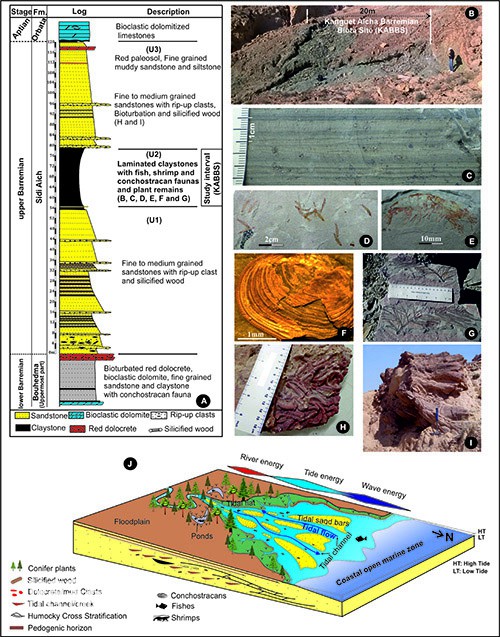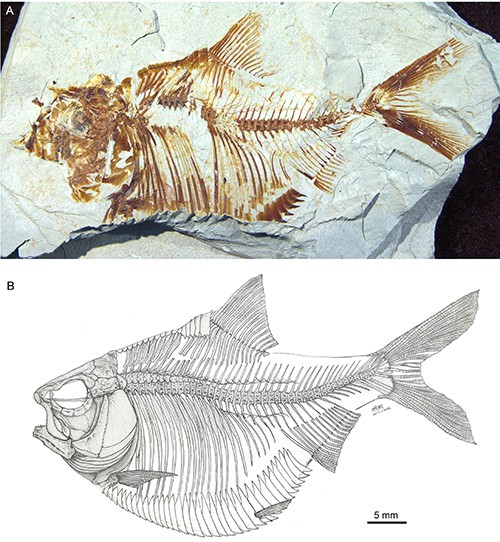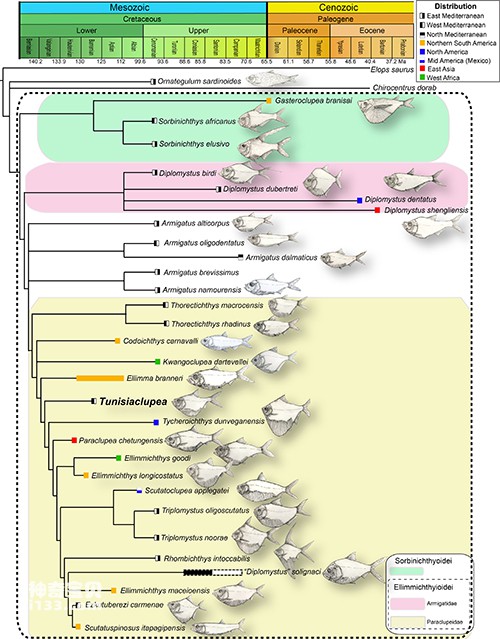Clupeomorpha fish are divided into two categories: Clupeoformes (such as sardines and Yangtze swordfish, etc.) and the extinct Ellimmichthyiformes. Eram herrings, commonly known as double armored herrings, were first recorded in the Early Cretaceous and continued into the Oligocene (Oligocene materials are still under study). They were once widely distributed in South America, West Africa, North America, the Mediterranean coast and East Asia. Most of the currently known species are produced in continental marine environments, and species after the Cretaceous are produced in freshwater environments affected by seawater, such as the Green River Shale of North America and the Shengli Oilfield of East China in the Eocene, and southern Guangxi in the Oligocene. . Among them, the Shengli double-edged herring (Diplomystus shengliensis) produced in the Shengli Oilfield has become the most important "trans-Pacific distribution pattern" of the Eocene fish fauna due to its high similarity with different fish species of the same genus in the Green River shale of North America at the same time. One of the evidences.
Recently, the "Journal of Vertebrate Paleontology" published online the research results led by Wu Feixiang's team from our institute and participated by geological colleagues from the University of Carthage and El Manar University in Tunisia. Based on the new material discovered in the Lower Cretaceous strata of the Chotts Basin in southern Tunisia, a new genus and species of the family Parachrysidae of the order Eram Herring was established, Tunisiaclupea speratus (Tunisiaclupea speratus), supplementing the Mediterranean region (Western Tethys The early records of this group (oceanic area) provide new information for studying the phylogenetic relationships and biogeographic history of Eram herring (Figure 1-3).
There are currently 13 genera and at least 35 valid species of Eram herring. Since the establishment of this order (Grande, 1985), there have been many differences in previous research results regarding their internal taxonomic relationships and biogeographic history. Based on the phylogenetic relationship constructed by new fossil materials and a morphological matrix containing the most complete species of this order (Fig. 3), this study classified the Tunisian herring into the Paraclupeidae family (Paraclupeidae Chang and Chou, 1977), and analyzed The internal taxonomic relationships within the family Paraphoridae have been adjusted. Tunisian herring is a relatively primitive type in the family Parachrysidae, and its systematic position is between the Early Cretaceous Ellimma branneri in Brazil and the Late Cretaceous Tycheroichthys dunveganensis in northern North America.
The Mediterranean region is a key area in the evolution history of Eram herring. Some major lineages of this order (such as Armigatidae and Sorbinichthyidae) may have originated in this area during the Late Cretaceous. At the same time, the Mediterranean Sea, as an important area in the evolution of the Tethys Ocean, has experienced extensive sea and land changes since the Cretaceous, and the water environment has been constantly changing. During the Cretaceous, Tunisia was located on the southern edge of the Western Tethys Ocean. It was once at the opening of the waterway connecting the Tethys Ocean to the expanding South Atlantic Ocean, and the latter was another hot spot in the evolution history of Eram herring. Previously, there were few fossil records of Eram herring in Tunisia, only "Diplomystus solignaci" from the Late Cretaceous. In recent years, the University of Carthage and the University of El Manar in Tunisia have carried out joint excavations in the Chotts Basin in southern Tunisia, and found abundant and well-preserved aquatic fossils in the Lower Cretaceous strata (Figure 1). The newly discovered Tunisian herring (Tunisiaclupea speratus) is the earliest fossil record of the Elamite herring in Tunisia and even the southern edge of the Western Tethys Ocean.
Based on the new phylogenetic relationship, this study clarified the zoogeographic history of Eram herring and proposed a new explanation for its diversity development process. We believe that the diversity of Elamite herring reached its peak in the Western Tethys Ocean (today's Mediterranean Sea) during the Cenomanian period of the Late Cretaceous, which may be related to the high sea level and extensive marine transgression at that time. When the Western Tethys Ocean was connected to the tropical Atlantic region by the surface sea running across the northern part of the African continent, the habitat expanded, the infusion of warm currents, and the increase in food input promoted the migration and spread of their populations, and led to the enhancement of allopatric speciation. This group gradually declined after the Cretaceous, and its youngest record currently comes from Ningming, Guangxi in the Oligocene.
According to current knowledge, the earliest representatives of Eram's herring are distributed in South America, the Mediterranean and East Asia (Paraclupea from the Early Cretaceous in Zhejiang). The biogeographical connection between the first two has been supported by phylogenetic evidence. The vast area between the Mediterranean and East Asia, including West Asia, South Asia and even southern Tibet, which was once the Neo-Tethyan Ocean, remains a blank area in its fossil record. As the name of the new fish "Hope Tunisian Herring" implies, we hope that with the advancement of future investigations and research, the last piece of this "jigsaw puzzle" will eventually be completed.
This research was supported by the Strategic Priority Science and Technology Project of the Chinese Academy of Sciences, the Center for Excellence in Biological Evolution and Environment, the National Natural Science Foundation of China, the Fund of the Tunisian Ministry of Scientific Research, and the Youth Innovation Promotion Association of the Chinese Academy of Sciences.
Original link:
;

Figure 1 Fossil-bearing strata (A-C), produced fossils (D-I) and paleoenvironmental reconstruction (J) of the Chotts Basin in Tunisia. Photo courtesy: Wu Feixiang

Figure 2. The holotype specimen of Tunisian herring (A) and the skeleton reconstruction (B). Photo courtesy: Wu Feixiang

Figure 3 Phylogenetic analysis results. Photo courtesy: Wu Feixiang
animal tags:
We created this article in conjunction with AI technology, then made sure it was fact-checked and edited by a Animals Top editor.